高中英语语法---强调句讲解
- 格式:docx
- 大小:14.78 KB
- 文档页数:4
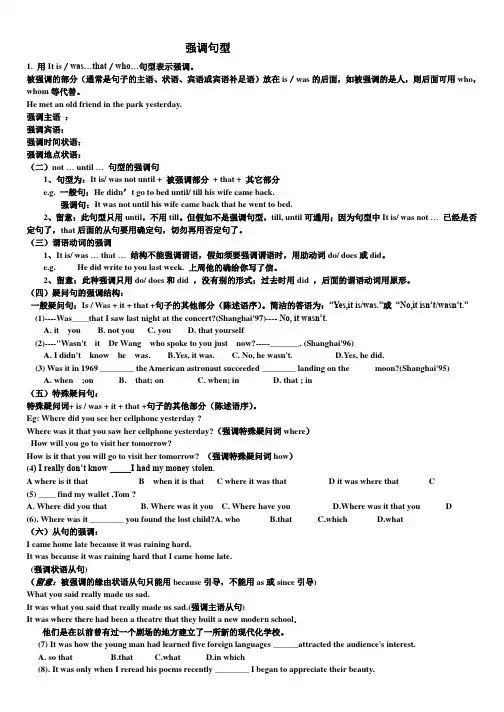
强调句型1. 用It is/was…that/who…句型表示强调。
被强调的部分(通常是句子的主语、状语、宾语或宾语补足语)放在is/was的后面,如被强调的是人,则后面可用who,whom等代替。
He met an old friend in the park yesterday.强调主语:强调宾语:强调时间状语:强调地点状语:(二)not … until …句型的强调句1、句型为:It is/ was not until + 被强调部分+ that + 其它部分e.g. 一般句:He didn’t go to bed until/ till his wife came back.强调句:It was not until his wife came back that he went to bed.2、留意:此句型只用until,不用till。
但假如不是强调句型,till, until可通用;因为句型中It is/ was not …已经是否定句了,that后面的从句要用确定句,切勿再用否定句了。
(三)谓语动词的强调1、It is/ was … that …结构不能强调谓语,假如须要强调谓语时,用助动词do/ does或did。
e.g. He did write to you last week. 上周他的确给你写了信。
2、留意:此种强调只用do/ does和did ,没有别的形式;过去时用did ,后面的谓语动词用原形。
(四)疑问句的强调结构:一般疑问句:Is / Was + it + that +句子的其他部分(陈述语序)。
简洁的答语为:“Yes,it is/was.”或“No,it isn’t/wasn’t.”(1)----Was____that I saw last night at the concert?(Shanghai'97)---- No, it wasn’t.A. it youB. not youC. youD. that yourself(2)----"Wasn't it Dr Wang who spoke to you just now?-----_______. (Shanghai'96)A. I didn't know he was.B.Yes, it was.C. No, he wasn't.D.Yes, he did.(3) Was it in 1969 ________ the American astronaut succeeded ________ landing on the moon?(Shanghai'95)A. when ;onB. that; onC. when; inD. that ; in(五)特殊疑问句:特殊疑问词+ is / was + it + that +句子的其他部分(陈述语序)。

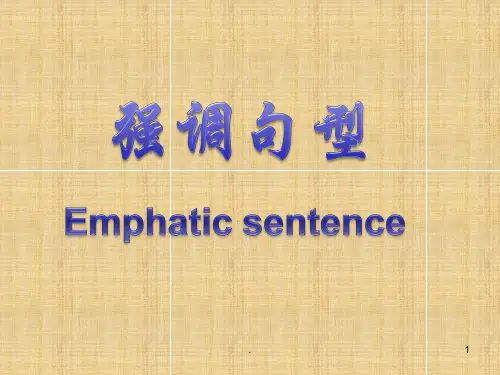
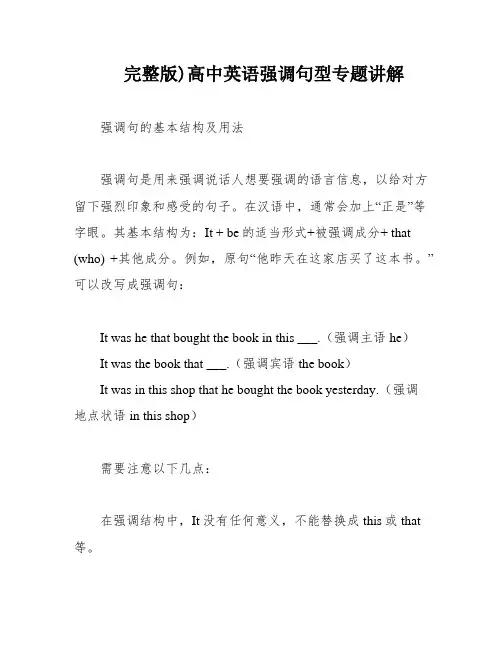
完整版)高中英语强调句型专题讲解强调句的基本结构及用法强调句是用来强调说话人想要强调的语言信息,以给对方留下强烈印象和感受的句子。
在汉语中,通常会加上“正是”等字眼。
其基本结构为:It + be的适当形式+被强调成分+ that (who) +其他成分。
例如,原句“他昨天在这家店买了这本书。
”可以改写成强调句:It was he that bought the book in this ___.(强调主语he)It was the book that ___.(强调宾语the book)It was in this shop that he bought the book yesterday.(强调地点状语in this shop)需要注意以下几点:在强调结构中,It没有任何意义,不能替换成this或that 等。
It is (was)…that (who)…是结构性词语,不能省略。
如果省略,剩下的部分在语法结构和句子含义上都是完整的,这正是它与定语从句等的本质区别。
当被强调部分指人时,可以用who(被强调部分的人作主语或宾语时)或者whom(被强调部分的人作宾语时)代替that;当被强调部分指物时通常用that;当被强调部分既包括人又包括物时,用that不用who。
当被强调部分是代词时,用who不用that。
当强调时间或地点或原因状语时,不能用when / where/why代替that(尤其是当这些状语为介词短语时)。
例如,下面两个句子中的强调句都是正确的:It was only when I ___.(强调时间状语when)It was in Qingdao that I saw the sea for the first time.(强调地点状语in Qingdao)About 600 years ago。
the first clock with a face and an hour hand was invented。
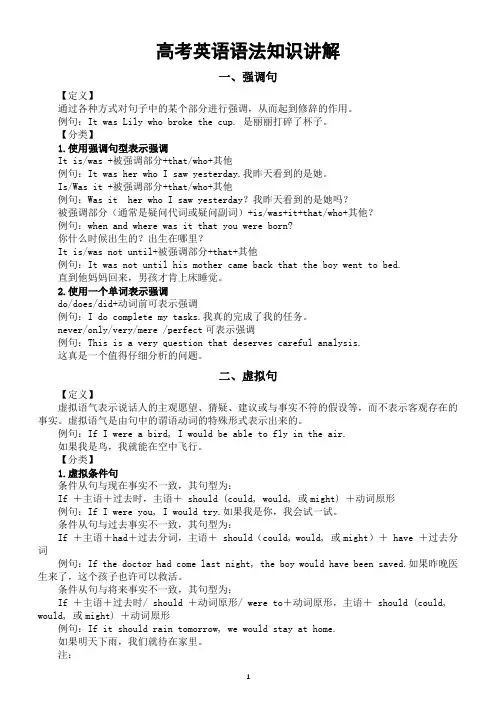
高考英语语法知识讲解一、强调句【定义】通过各种方式对句子中的某个部分进行强调,从而起到修辞的作用。
例句:It was Lily who broke the cup. 是丽丽打碎了杯子。
【分类】1.使用强调句型表示强调It is/was +被强调部分+that/who+其他例句:It was her who I saw yesterday.我昨天看到的是她。
Is/Was it +被强调部分+that/who+其他例句:Was it her who I saw yesterday?我昨天看到的是她吗?被强调部分(通常是疑问代词或疑问副词)+is/was+it+that/who+其他?例句:when and where was it that you were born?你什么时候出生的?出生在哪里?It is/was not until+被强调部分+that+其他例句:It was not until his mother came back that the boy went to bed.直到他妈妈回来,男孩才肯上床睡觉。
2.使用一个单词表示强调do/does/did+动词前可表示强调例句:I do complete my tasks.我真的完成了我的任务。
never/only/very/mere /perfect可表示强调例句:This is a very question that deserves careful analysis.这真是一个值得仔细分析的问题。
二、虚拟句【定义】虚拟语气表示说话人的主观愿望、猜疑、建议或与事实不符的假设等,而不表示客观存在的事实。
虚拟语气是由句中的谓语动词的特殊形式表示出来的。
例句:If I were a bird, I would be able to fly in the air.如果我是鸟,我就能在空中飞行。
【分类】1.虚拟条件句条件从句与现在事实不一致,其句型为:If +主语+过去时,主语+ should (could, would, 或might) +动词原形例句:If I were you, I would try.如果我是你,我会试一试。
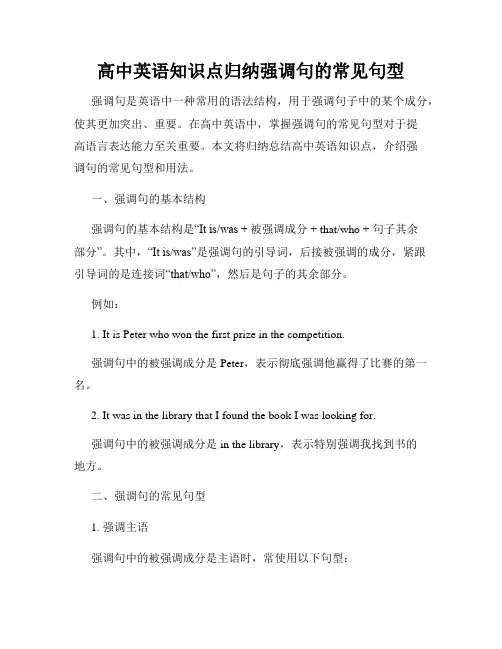
高中英语知识点归纳强调句的常见句型强调句是英语中一种常用的语法结构,用于强调句子中的某个成分,使其更加突出、重要。
在高中英语中,掌握强调句的常见句型对于提高语言表达能力至关重要。
本文将归纳总结高中英语知识点,介绍强调句的常见句型和用法。
一、强调句的基本结构强调句的基本结构是“It is/was + 被强调成分 + that/who + 句子其余部分”。
其中,“It is/was”是强调句的引导词,后接被强调的成分,紧跟引导词的是连接词“that/who”,然后是句子的其余部分。
例如:1. It is Peter who won the first prize in the competition.强调句中的被强调成分是Peter,表示彻底强调他赢得了比赛的第一名。
2. It was in the library that I found the book I was looking for.强调句中的被强调成分是in the library,表示特别强调我找到书的地方。
二、强调句的常见句型1. 强调主语强调句中的被强调成分是主语时,常使用以下句型:It is/was + 被强调的主语 + that/who + 句子其余部分例如:It was Mary who broke the window.是玛丽打破了窗户。
2. 强调宾语强调句中的被强调成分是宾语时,常使用以下句型:It is/was + 被强调的宾语 + that/who + 句子其余部分例如:It was Tom who I saw at the park.是我在公园看到的是汤姆。
3. 强调地点状语强调句中的被强调成分是地点状语时,常使用以下句型:It is/was + 被强调的地点状语 + that/where + 句子其余部分例如:It was in the kitchen that I found the missing keys.是在厨房里我找到了丢失的钥匙。
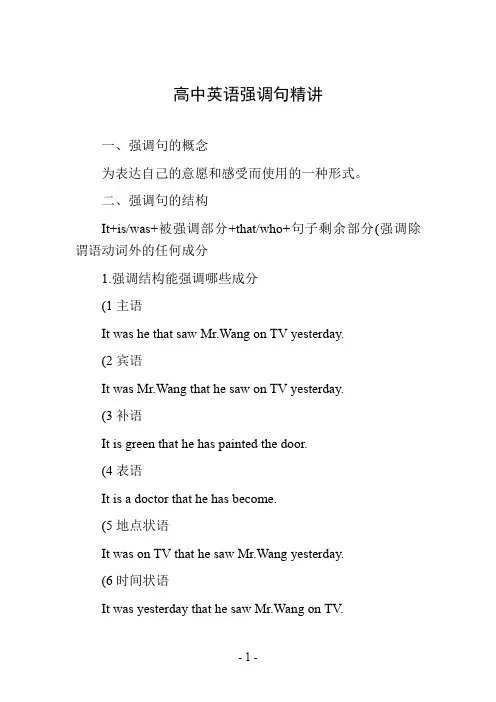
高中英语强调句精讲一、强调句的概念为表达自己的意愿和感受而使用的一种形式。
二、强调句的结构It+is/was+被强调部分+that/who+句子剩余部分(强调除谓语动词外的任何成分1.强调结构能强调哪些成分(1主语It was he that saw Mr.Wang on TV yesterday.(2宾语It was Mr.Wang that he saw on TV yesterday.(3补语It is green that he has painted the door.(4表语It is a doctor that he has become.(5地点状语It was on TV that he saw Mr.Wang yesterday.(6时间状语It was yesterday that he saw Mr.Wang on TV.(7方式状语It was by bike that we went to the park.(8各类从句It was what he said that surprised me.It was because the book was so useful for my work that I bought it.(9强调not…until..中的时间状语It was not untill his father came back home that he went to bed.原句:he didn’t go tobed until his father came back home.(10强调非谓语动词It was playing computer games that cost the boy a lot of money.2.强调结构的疑问式及其回答(1一般疑问句Was it you who put these books on my desk?原句:Did you put these books on my desk?(2特殊疑问句Who was it that gave you the book?原句:Who gave you the book?(3反意疑问句It was Tom who broke the window,wasn’t it?原句:Did Tom break the wind ow,didn’t he?13.强调结构的几个易错点(1关于结构中的that除强调主语和宾语的人时可用who,其他任何情况都用thatIt was Kate that/who told me about it.(2关于结构中be的形式原句谓语动词是过去式时,强调句中的be用was;原句谓语动词是现在时或将来时,强调句中的be用is.注:be有时与表示推测的情态动词连用It must be John that/who cleand the room.(3关于主谓一致问题被强调的是原句主语时,要注意that/who后的谓语动词与原句主语一致。
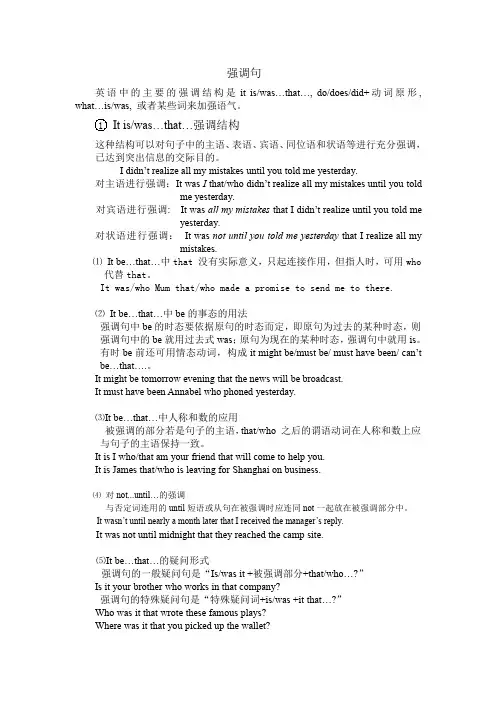
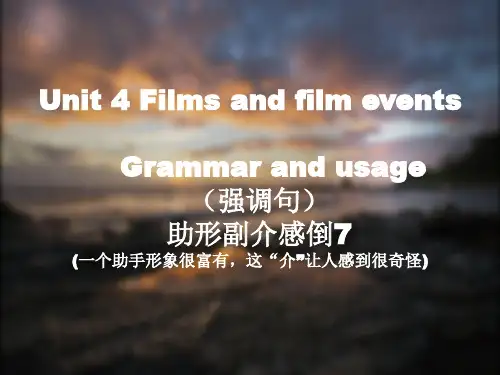
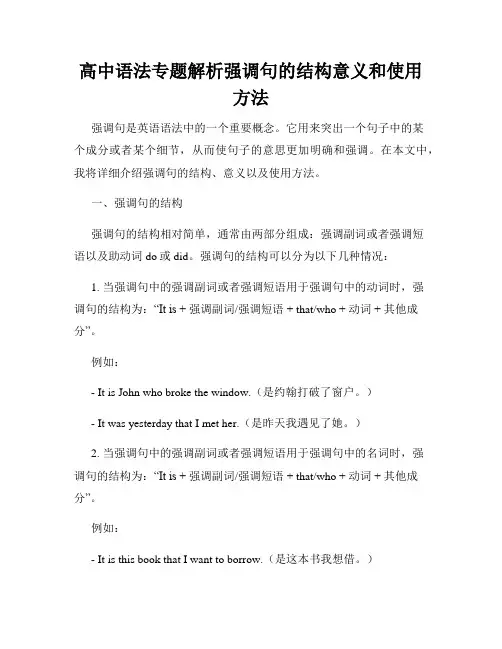
高中语法专题解析强调句的结构意义和使用方法强调句是英语语法中的一个重要概念。
它用来突出一个句子中的某个成分或者某个细节,从而使句子的意思更加明确和强调。
在本文中,我将详细介绍强调句的结构、意义以及使用方法。
一、强调句的结构强调句的结构相对简单,通常由两部分组成:强调副词或者强调短语以及助动词do或did。
强调句的结构可以分为以下几种情况:1. 当强调句中的强调副词或者强调短语用于强调句中的动词时,强调句的结构为:“It is + 强调副词/强调短语 + that/who + 动词 + 其他成分”。
例如:- It is John who broke the window.(是约翰打破了窗户。
)- It was yesterday that I met her.(是昨天我遇见了她。
)2. 当强调句中的强调副词或者强调短语用于强调句中的名词时,强调句的结构为:“It is + 强调副词/强调短语 + that/who + 动词 + 其他成分”。
例如:- It is this book that I want to borrow.(是这本书我想借。
)- It was my father who gave me the gift.(是我爸爸给了我礼物。
)3. 当强调句中的强调副词或者强调短语用于强调句中的形容词或副词时,强调句的结构为:“It + is + 形容词/副词 + that + 动词 + 其他成分”。
例如:- It is so hot that we can't go outside.(天气太热了,我们不能出去。
)- It was very loud that I couldn't hear him.(声音很大,我听不见他。
)二、强调句的意义强调句的使用可以使句子的意思更加明确和强调。
它在交流中的作用非常重要,可以帮助说话者突出某个特定的信息,使得对方注意到这个信息并理解说话者的意图。
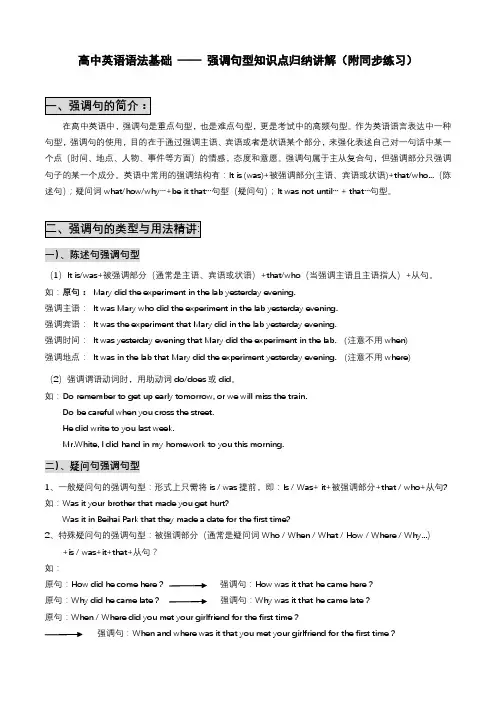
高中英语语法基础——强调句型知识点归纳讲解(附同步练习)在高中英语中,强调句是重点句型,也是难点句型,更是考试中的高频句型。
作为英语语言表达中一种句型,强调句的使用,目的在于通过强调主语、宾语或者是状语某个部分,来强化表述自己对一句话中某一个点(时间、地点、人物、事件等方面)的情感,态度和意愿。
强调句属于主从复合句,但强调部分只强调句子的某一个成分。
英语中常用的强调结构有:It is (was)+被强调部分(主语、宾语或状语)+that/who...(陈述句);疑问词what/how/why…+be it that…句型(疑问句);It was not until… + that…句型。
一)、陈述句强调句型(1)It is/was+被强调部分(通常是主语、宾语或状语)+that/who(当强调主语且主语指人)+从句。
如:原句:Mary did the experiment in the lab yesterday evening.强调主语:It was Mary who did the experiment in the lab yesterday evening.强调宾语:It was the experiment that Mary did in the lab yesterday evening.强调时间:It was yesterday evening that Mary did the experiment in the lab. (注意不用when)强调地点:It was in the lab that Mary did the experiment yesterday evening. (注意不用where)(2)强调谓语动词时,用助动词do/does或did。
如:Do remember to get up early tomorrow, or we will miss the train.Do be careful when you cross the street.He did write to you last week.Mr.White, I did hand in my homework to you this morning.二)、疑问句强调句型1、一般疑问句的强调句型:形式上只需将is / was提前,即:Is / Was+ it+被强调部分+that / who+从句? 如:Was it your brother that made you get hurt?Was it in Beihai Park that they made a date for the first time?2、特殊疑问句的强调句型:被强调部分(通常是疑问词Who / When / What / How / Where / Why...)+is / was+it+that+从句?如:原句:How did he come here ? 强调句:How was it that he came here ?原句:Why did he came late ? 强调句:Why was it that he came late ?原句:When / Where did you met your girlfriend for the first time ?强调句:When and where was it that you met your girlfriend for the first time ?三)、not...until...强调句型1、句型为:It is/was not until+被强调部分+that+从句。
高中英语强调句解析强调句(一)强调句句型1、陈述句的强调句型:I t i s/ w as +被强调部分(通常是主语、宾语或状语)+ t hat/ w ho(强调主语且主语指人可以用w ho,当然也可以使用t hat)+其它部分。
强调句式只是把句子中某些词(被强调部分)改变位置,所以把强调结构(i t i s/w as... t hat/w ho)去掉之后,句子一定是完整的e.g.It w as y es t e rd ay t hat he me t Li Pi ng.2、一般疑问句的强调句型:同上,只是把i s/w as提到i t前面。
e.g.Was i t y e s te rd ay t hat he me t Li P i ng?3、特殊疑问句的强调句型:被强调部分(通常是疑问代词或疑问副词)+ i s/ w as +i t+ t hat/w ho +其它部分?e.g.Whe n and w he re w as i t t hat y ou w e re born?4、强调句例句:I me t Li Mi ng at t he rai l w ay st at i on y e st e rd ay.强调主语:I t w as I t hat(w ho)me t Li Mi ng at t he rai l w ay s t ati on y e s te rd ay.强调宾语:I t w as Li Mi ng t hat I me t at t he rai l w ay st at i on y e st e rd ay.强调地点状语:I t w as at t he rai l w ay s t at i on t hat I met Li Mi ng y e st e rd ay.强调时间状语:I t w as y e st e rd ay t hat I me t Li Mi ng at t he rai l w ay st at i on.5、注意:构成强调句的i t本身没有词义;强调句中的连接词一般只用t hat, w ho,即使在强调时间状语和地点状语时也如此,t hat, w ho不可省略;强调句中的时态只用两种,一般现在时和一般过去时。
强调句一、强调句的基本结构及用法强调句常用来突出说话人要强调的语言信息,给对方以强烈的印象和感受。
译成汉语时,常加上“正是”等字眼。
其基本结构是:It + be的适当形式+ 被强调成分+ that (who) + 其他成分He bought the book in this shop yesterday.→It was he that bought the book in this shop yesterday. (强调主语he)→It was the book that he bought in this shop yesterday. (强调宾语the book)→It was in this shop that he bought the book yesterday. (强调地点状语in this shop)【注意】1.在该强调结构中,It无任何意义但不可以换成this或者that等。
It is (was)…that (who)…为结构词,假如去掉,剩下部分在语法结构和句子含义上均完整,这一点正是它和定语从句等的本质区别。
2.关于that与who当被强调部分指人时,可以用who(被强调部分的人作主语或宾语时)或者whom(被强调部分的人作宾语时)代替that;当被强调部分指物时通常用that;当被强调部分既包括人又包括物,用that不用who.It was the things and people that they remembered that they were talking abo ut.当被强调部分是代词时,用who不用that。
当强调时间或地点或原因状语时,不能用when / where /why代替that(尤其是当这些状语为介词短语时)。
1)It was only when I reread his poems recently I began to appreciate their beauty.A. untilB. thatC. whenD. so2)It was in Qingdao I saw the sea for the first time.A. whatB. thatC. whenD. which3)It was because of bad weather the football match had to be put off.A. soB. so thatC. whyD. that如果被强调的成分有同位语,同位语也应提前。
高中英语语法基础——强调句型知识点归纳讲解(附同步练习)在高中英语中,强调句是重点句型,也是难点句型,更是考试中的高频句型。
作为英语语言表达中一种句型,强调句的使用,目的在于通过强调主语、宾语或者是状语某个部分,来强化表述自己对一句话中某一个点(时间、地点、人物、事件等方面)的情感,态度和意愿。
强调句属于主从复合句,但强调部分只强调句子的某一个成分。
英语中常用的强调结构有:It is (was)+被强调部分(主语、宾语或状语)+that/who...(陈述句);疑问词what/how/why…+be it that…句型(疑问句);It was not until… + that…句型。
一)、陈述句强调句型(1)It is/was+被强调部分(通常是主语、宾语或状语)+that/who(当强调主语且主语指人)+从句。
如:原句:Mary did the experiment in the lab yesterday evening.强调主语:It was Mary who did the experiment in the lab yesterday evening.强调宾语:It was the experiment that Mary did in the lab yesterday evening.强调时间:It was yesterday evening that Mary did the experiment in the lab. (注意不用when)强调地点:It was in the lab that Mary did the experiment yesterday evening. (注意不用where)(2)强调谓语动词时,用助动词do/does或did。
如:Do remember to get up early tomorrow, or we will miss the train.Do be careful when you cross the street.He did write to you last week.Mr.White, I did hand in my homework to you this morning.二)、疑问句强调句型1、一般疑问句的强调句型:形式上只需将is / was提前,即:Is / Was+ it+被强调部分+that / who+从句? 如:Was it your brother that made you get hurt?Was it in Beihai Park that they made a date for the first time?2、特殊疑问句的强调句型:被强调部分(通常是疑问词Who / When / What / How / Where / Why...)+is / was+it+that+从句?如:原句:How did he come here ? 强调句:How was it that he came here ?原句:Why did he came late ? 强调句:Why was it that he came late ?原句:When / Where did you met your girlfriend for the first time ?强调句:When and where was it that you met your girlfriend for the first time ?三)、not...until...强调句型1、句型为:It is/was not until+被强调部分+that+从句。
强调句
1. 陈述句的强调句型
It is/ was + 被强调部分(通常是主语、宾语或状语)+ that/ who(当强调主语且主语指人)+ 其他部分。
例子 It was yesterday that he met Li Ping.
2. 一般疑问句的强调句型
同上,只是把is/ was提到it前面。
例子 Was it yesterday that he met Li Ping?
3. 特殊疑问句的强调句型
被强调部分(通常是疑问代词或疑问副词)+ is/ was + it + that/ who + 其他部分?
例子 When and where was it that you were born?
4.not … until … 句型的强调句
A. 句型为:It is/ was not until + 被强调部分 + that + 其他部分
普通句:He didn't go to bed until/ till his wife came back.
强调句:It was not until his wife came back that he went to bed.
B. 注意:
此句型只用until,不用till。
但如果不是强调句型,till, until可通用;因为句型中It is/ was not ... 已经是否定句了,that后面的从句要用肯定句,切勿再用否定句了。
5.谓语动词的强调
A. It is/ was ... that ... 结构不能强调谓语,如果需要强调谓语时,用助动词do/ does或did
Do sit down. 务必请坐。
Do be careful when you cross the street. 过马路时,务必(千万)要小心啊!
B. 注意:
此种强调只用do/ does和did,没有别的形式;过去时用did,后面的谓语动词用原形。
强调形式
常见到的强调形式,共有以下七类:
⒈用do\does\did + V可表强调
Some people do believe that nuclear power poses a threat to the world peace.
⒉adv或adj可表强调:Never \ only\ Very
This is the very question that deserves careful analysis.
⒊双重否定可表强调
Taking part-time jobs is never without drawbacks.
⒋what引导的主从可表强调
What really matters is cooperation.
⒌倒装可表强调(凡是倒装都可以表示强调)
Little do people take into account the seriousness of this problem.
⒍比较状语从句可表强调
Nothing is more imperative than to learn from the past.
⒎强调句型可表强调
It is \was +被强调部份+ that \ who +原句剩余部份
It is stability that destroys people’s ambition and barricades people’s steps.
语法结构
强调句的十种结构:
1.用助动词“do(does/did)+动词原形”来表示强调:
Do write to me when you get there.你到那儿后务必给我来信。
2.用形容词very,only,single,such等修饰名词或形容词来加强语气:How dare you buy such expensive jewels?你怎么敢买这么贵的宝石呢?
3.用ever,never,very,just等副词和badly,highly,really等带有-l y 的副词来进行强调:
I really don’t know what to do next.我的确不知道下一步该怎么做。
4.用in the world,on earth,at all等介词短语可以表达更强的语气(常用于疑问句):
Where in the world could he be?他到底会在哪儿?
5.用感叹句来表示强烈的感情,突出说话人的情感:
How interesting a story it is!这是一个多么有趣的故事啊!
6.用重复来表示强调:
Why!why!The cage is empty!啊!啊!箱子是空的。
7.用倒装句(也就是将要强调的句子或被强调的部分置于句首)来加强语气:On the table were some flowers.桌上摆着一些花。
(强调地点)
8.用强调句型:“It is(was)+被强调的部分+that(who)+原句其它部分”来强调说话人的意愿:
It was on Monday night that all this happened.所有这一切发生在周一晚上。
9.用If来表示强调:
1)If从句+I don’t know who/what,etc.does/is/has,etc.
主语部分也可以用nobody does/is/has,etc.或everybody does/is/has,et c.来代替(这里的if从句往往是正话反说,反话正说):
I f he can’t do it,I don’t know who can.要是他做不了这件事,我不知道还有谁能做。
(强调只有他能做) If Jim is a coward,everybody is.要是吉姆是个胆小鬼,那么人人都是胆小鬼。
(强调吉姆不是胆小鬼)
2)if从句+it be主句(此用法可看成是第8中强调句型的变形,即把所要强调的内容放在it be的后面,把其它内容放在由if引导的从句中):
If anyone knew the truth,it was Tom.如果说谁了解事实的真相,那便是汤姆。
10.用破折号、黑体字也可以表示强调,加强语气:
It’s because of hard work—ten years of hard work.那是因为艰苦的工作--十年艰苦的工作!
He began the work in late May.他在五月底开始的这项工作。
(强调时间)注意事项
that后的强调句如果是原因状语从句,从句只能用because引导,不能用since,as或why。
It was because the water had risen that they could not cross the river。